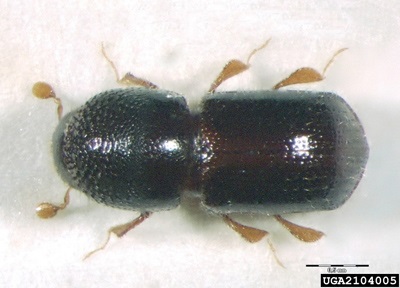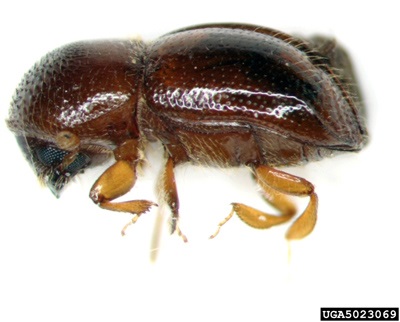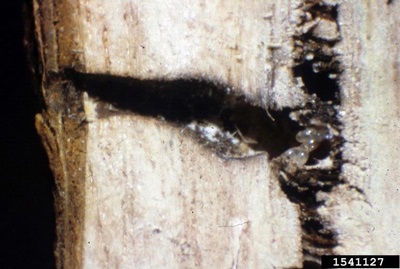Ambrosia beetles in apple orchards
Learn how to identify Ambrosia beetles and the damage they do to apple orchards.
Last month at the Great Lakes Fruit Workers' meeting in Traverse City Michigan, we heard about a new problem affecting apparently healthy apple orchards in New York (as reported by Deborah Breth, Cornell Cooperative Extension): black stem borer (BSB, Xylosandrus germanus) (Figure 1 and 2). Over the last couple of years, growers have been reporting dying trees with signs of borers and oozing sap. Since 2013, 25 affected sites with dying apple trees have been identified, ranging from new to 15 year old plantings.
The BSB belongs to a group of insects known ambrosia beetles (Subfamily Scolytinae, Tribe Xyleborini). Many of these, including the BSB, have been introduced to North America and are continuing to expand their ranges. The BSB was first identified in Long Island, NY in 1932, and in Canada near Point Pelee, ON in 1994.
While ambrosia beetles typically invade cut or distressed trees, some will attack apparently healthy trees. For example, another recent arrival in Ontario, granulate (Asian) ambrosia beetle (GAB, Xylosandrus crassiusculus), is a serious pest of nursery material and fruit trees in parts of the US (including apple Malus, pear Pyrus, and peach Prunus). Host range of ambrosia beetles is often broad.
Ambrosia beetles such as the BSB and the GAB bore 1.5 mm tunnels through the bark and into the heartwood of trees, to a depth of 1 or 2 cm. In contrast, related bark beetles or shothole borers tunnel through the bark and form shallow galleries running parallel to the wood grain; if you were to peel back the bark of trees, you would see the galleries. With ambrosia beetles, you would see a series of shotholes but no galleries under the bark. Both bark beetles and ambrosia beetles can attack fruit trees.
Females excavate a series of short galleries off the main tunnel (or a single large brood chamber) where eggs are laid and larvae reared (Figure 3).
Larvae do not feed on the wood. Instead, females introduce and cultivate an ambrosia fungus (often specific to a given beetle species) within the galleries that is used as a food source by the developing larvae. Adult BSB overwinter in chambers at the base of infested trees, and females move to new sites in the spring. Development from egg to adult takes about 30 days, resulting in 2 generations per year.
Branches and stems of affected trees may wilt and die, and larger branches and trunks may become riddled with galleries, creating weak points that are subject to breakage. Toothpick-sized tubes of sawdust can be seen coming out of large branches and the trunk. Heartwood that is infested with ambrosia beetles is typically stained dark brown or black along gallery walls. In addition to the direct damage caused by boring into heartwood, females may also introduce Fusarium fungus, resulting in the formation of cankers and withering of crowns. Damage is sometimes confused with fire blight.
Options for managing ambrosia beetles are limited. Maintaining tree vigour, latex paint on trunks, removal of infested trees / branches (plus burning or chipping) can help to reduce infestations. Trap logs — fresh cut pieces of hardwood logs 1–2 metre long placed at intervals along orchard edges — have been used with some success; logs must be removed and destroyed before any new adults emerge. Trunk sprays are also being evaluated at Cornell.
We are interested in tracking ambrosia beetles in fruit trees in Ontario. If you think you are seeing injury from bark beetles, please let us know.


